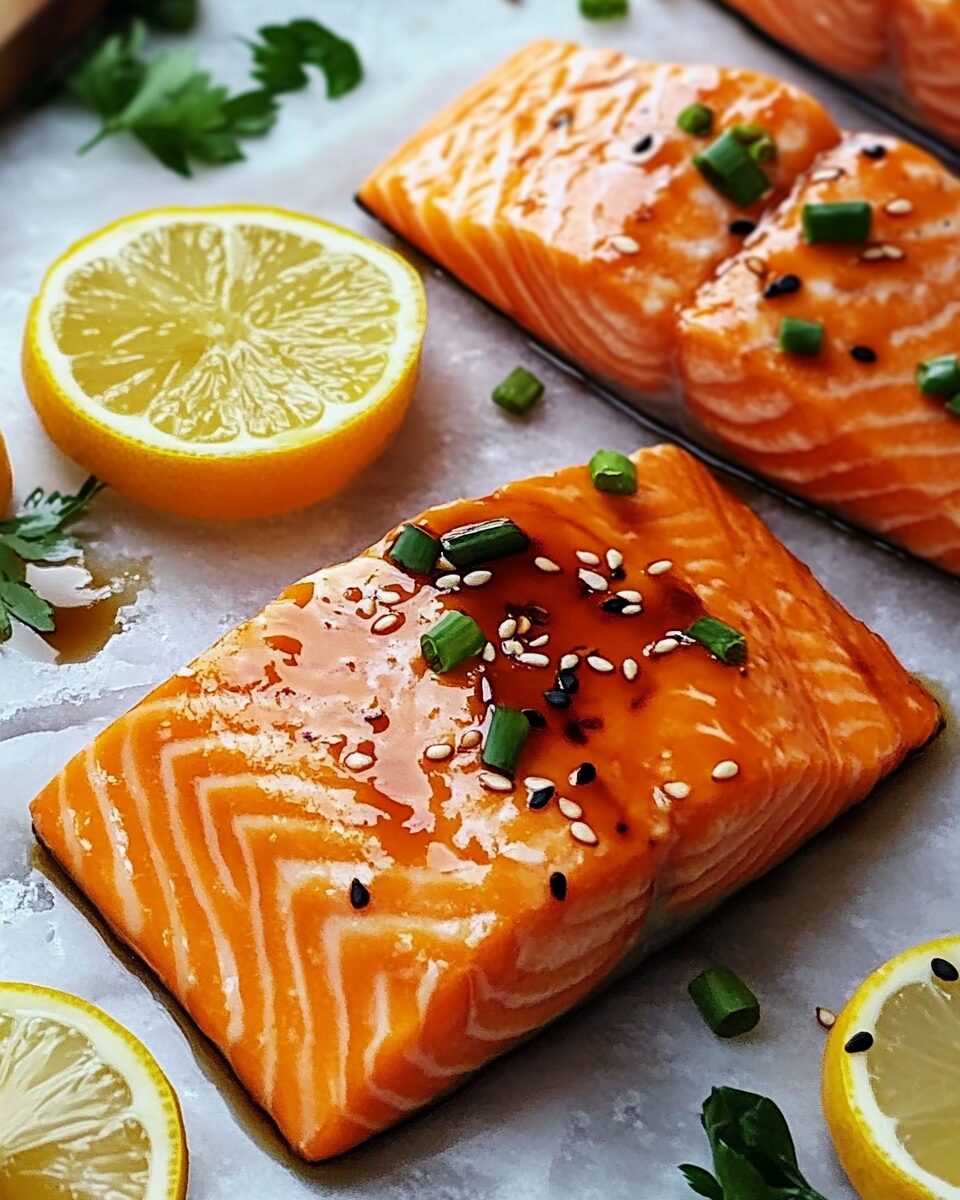This Baked Teriyaki Salmon recipe combines the rich, savory flavors of teriyaki sauce with the delicate taste of salmon. The salmon fillets are marinated in a flavorful sauce made from soy sauce, honey, sesame oil, and fresh ginger, then baked to perfection. The result is a dish that is both tender and bursting with umami, perfect for a quick weeknight dinner or a special occasion. Enjoy it with your favorite side dishes for a complete meal!
FULL RECIPE
Ingredients
- 4 salmon fillets
- 1/4 cup soy sauce
- 2 tbsp honey
- 2 tbsp rice vinegar
- 1 tbsp sesame oil
- 1 clove garlic, minced
- 1 tsp grated fresh ginger
- 1 tbsp sesame seeds
- 2 green onions, chopped
- Salt and pepper to taste
Directions
- Preheat your oven to 400°F (200°C).
- In a small bowl, whisk together soy sauce, honey, rice vinegar, sesame oil, garlic, and ginger.
- Place the salmon fillets on a baking sheet lined with parchment paper.
- Season the fillets with salt and pepper.
- Brush the teriyaki sauce mixture generously over the salmon fillets.
- Bake the salmon in the preheated oven for 12-15 minutes, or until the salmon flakes easily with a fork.
- Remove from the oven and sprinkle with sesame seeds and chopped green onions before serving.
Nutritional Information
- Calories: 280
- Protein: 23g
- Fat: 18g
- Carbohydrates: 13g
- Fiber: 1g
- Sugar: 9g
History of Teriyaki Sauce
Teriyaki sauce, a key component of this recipe, has its origins in Japan. The word “teriyaki” is derived from two Japanese words: “teri,” meaning shine or luster, and “yaki,” meaning grilled or broiled. Traditionally, teriyaki sauce is made from soy sauce, sake or mirin, and sugar, which are combined to create a savory-sweet glaze that is perfect for grilling or broiling. Over time, the sauce has evolved and become a popular marinade or glaze in various culinary traditions, particularly in the United States, where it’s often used on meats like chicken, beef, and, of course, salmon.
Health Benefits of Salmon
Salmon is known for being one of the healthiest fish you can eat. It is rich in high-quality protein, essential for muscle repair and growth. Moreover, salmon is an excellent source of omega-3 fatty acids, which are known for their heart-healthy properties. Omega-3s help reduce inflammation, lower blood pressure, and decrease the risk of heart disease. It’s also a great source of vitamin D, a nutrient important for bone health, and B-vitamins that support energy production and immune function.
Why Bake Salmon?
Baking salmon is one of the best methods to cook it as it helps retain moisture and ensures that the fish cooks evenly. Unlike grilling, which can dry out delicate fish, baking in the oven allows the salmon to remain tender and flaky. The process of baking also allows the flavors from the teriyaki marinade to infuse into the salmon, creating a more flavorful dish. Additionally, baking requires little active cooking time, making it a convenient method for busy home cooks.
Teriyaki Glaze and its Versatility
The beauty of teriyaki glaze is its versatility. While it is commonly used on fish like salmon, it can also be used on chicken, pork, beef, and even vegetables. The sauce’s balance of salty, sweet, and savory flavors makes it a popular choice for many different cuisines. You can also adjust the ingredients to suit your taste, such as adding more honey for sweetness or more soy sauce for saltiness.
The Role of Soy Sauce in Teriyaki
Soy sauce is the backbone of teriyaki sauce. It imparts a rich umami flavor to the dish, which enhances the overall taste. While traditional teriyaki uses Japanese soy sauce, which is typically lighter in color and flavor, many modern recipes use dark soy sauce for a deeper color and stronger flavor. Whether you use traditional or dark soy sauce, it is essential to balance the amount of soy sauce used with the other ingredients to achieve the perfect flavor profile for your teriyaki sauce.
How to Make Teriyaki Sauce from Scratch
Making teriyaki sauce from scratch is surprisingly easy. All you need is soy sauce, honey or sugar, rice vinegar, sesame oil, and some garlic and ginger. The sauce can be quickly mixed and heated to thicken, and you can adjust the flavors to suit your preferences. Homemade teriyaki sauce often tastes fresher and more authentic than store-bought versions, and you can control the sweetness and saltiness levels to match your tastes.
The Importance of Marinating Salmon
Marinating salmon in teriyaki sauce before baking is an essential step that helps the fish absorb the flavors of the sauce. A good marinate time is anywhere from 15 minutes to an hour. This allows the salmon to develop deeper flavor without overpowering the natural taste of the fish. Marinating also helps the salmon retain moisture, ensuring it remains tender and juicy throughout the cooking process.
Pairing Baked Teriyaki Salmon with Side Dishes
Baked teriyaki salmon is a flavorful dish that pairs wonderfully with a variety of sides. For a lighter meal, serve it with steamed vegetables like broccoli or asparagus. Rice, particularly jasmine or basmati rice, is also a great option to complement the flavors of the fish. Additionally, a simple side salad with a tangy dressing can help balance the richness of the salmon. For a more filling meal, consider pairing it with roasted potatoes or a quinoa salad.
How to Achieve the Perfect Baked Salmon
To ensure your salmon is perfectly baked, be mindful of the cooking time. The general rule of thumb is to bake the salmon for 10 minutes per inch of thickness. This allows the fish to cook evenly and remain moist. Overcooking can result in dry, tough salmon, so keep an eye on it as it bakes. The fish should be tender and flaky when done, with a slight pinkness in the center.
The Role of Sesame Oil in Teriyaki Salmon
Sesame oil is a key ingredient in this baked teriyaki salmon recipe, adding a nutty and aromatic flavor to the dish. It enhances the overall depth of the sauce and complements the natural richness of the salmon. There are two types of sesame oil: toasted and untoasted. Toasted sesame oil, which has a stronger flavor, is commonly used in Asian cooking for finishing dishes or adding depth to sauces, while untoasted sesame oil is often used for frying or cooking at higher temperatures.
The Importance of Fresh Garlic and Ginger
Fresh garlic and ginger are essential for adding depth and complexity to the teriyaki marinade. Garlic provides a pungent, savory flavor, while ginger adds a subtle spiciness and warmth. Both ingredients complement the sweetness of the honey and the saltiness of the soy sauce, creating a balanced and flavorful marinade. Fresh garlic and ginger will always offer more vibrant flavors than their dried or powdered counterparts.
The Best Type of Salmon for Baking
When choosing salmon for baking, wild-caught Alaskan salmon is often considered the best option due to its firm texture and rich flavor. However, farmed salmon can also work well in this recipe. The key is to choose salmon fillets that are fresh and have a bright, vibrant color. If you’re able to find it, opt for sockeye or king salmon, as these varieties have a robust flavor and are perfect for glazing with teriyaki sauce.
Teriyaki Salmon and Japanese Cuisine
Teriyaki salmon is a popular dish in Japanese cuisine. The use of teriyaki as a marinade or glaze has become a hallmark of Japanese cooking, known for its balance of sweet and savory flavors. In Japan, teriyaki is often used to enhance the flavor of grilled fish, particularly salmon. This dish is often served in Japanese restaurants worldwide, and its simplicity and delicious flavor make it a favorite among diners of all ages.
Sweet and Savory Flavor Profile
The balance of sweet and savory flavors in teriyaki salmon is what makes it so appealing. The sweetness comes from the honey or sugar in the sauce, while the savory notes come from the soy sauce and sesame oil. This harmonious blend of flavors makes it a great choice for a wide variety of palates. The sweetness in the sauce also helps to caramelize the top of the salmon as it bakes, creating a beautiful, glossy finish.
The Art of Cooking with Marinades
Marinades are a fantastic way to infuse proteins with flavor. They work by allowing the ingredients to penetrate the outer layers of the food, creating a more flavorful and tender dish. When marinating salmon, it’s important to avoid over-marinating, as the fish can become too salty or overly saturated. A short marinate time, around 15-30 minutes, is typically enough to achieve a well-balanced flavor without compromising the texture.
The Healthiest Way to Cook Salmon
Baking is one of the healthiest methods for cooking salmon, as it doesn’t require added oils or fats. Baking preserves the nutrients and natural oils in the fish, including omega-3 fatty acids. This cooking method also reduces the risk of overcooking, which can cause the salmon to lose its beneficial oils. For an even healthier option, you can bake the salmon on a rack to allow excess fat to drain away during the cooking process.
How to Store Leftover Teriyaki Salmon
If you have leftover teriyaki salmon, storing it properly is important to preserve its freshness. Let the salmon cool to room temperature before placing it in an airtight container. It can be stored in the refrigerator for up to 2-3 days. To reheat, use a gentle method, such as warming it in the microwave or briefly reheating it in the oven at a low temperature to avoid drying it out.
Teriyaki Salmon for Special Occasions
Baked teriyaki salmon is a great choice for special occasions. Its rich flavor and elegant presentation make it suitable for dinner parties, family gatherings, or even holiday meals. You can serve it with festive sides such as roasted vegetables, rice pilaf, or even a fresh, tangy slaw. Its versatility also allows it to pair well with a variety of beverages, from light white wines to chilled sake.
The Impact of Marinade Time on Flavor
The amount of time you marinate the salmon in teriyaki sauce can affect the overall flavor of the dish. A longer marinade time allows the fish to absorb more of the sauce’s flavors, but be cautious not to marinate it for too long. Over-marinating can make the fish too salty or change its texture. A balance of 15-30 minutes is typically ideal for this recipe, ensuring that the fish is flavorful without becoming too overpowering.
Conclusion
Baked teriyaki salmon is a delicious and healthy dish that combines the natural flavors of salmon with the sweet and savory notes of teriyaki sauce. It’s an easy yet impressive meal that works for both casual dinners and special occasions. With its quick preparation time and minimal ingredients, this recipe is perfect for those looking to enjoy a flavorful and nutritious meal with little effort. Whether you’re an experienced cook or a beginner, this dish is sure to become a family favorite.






